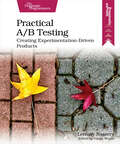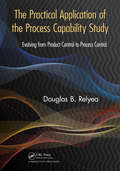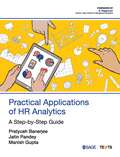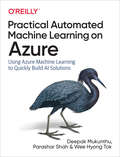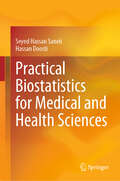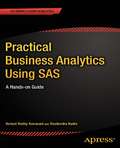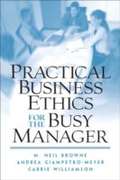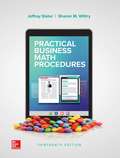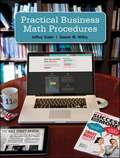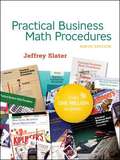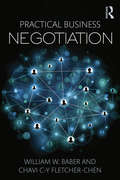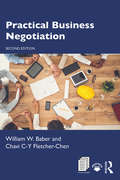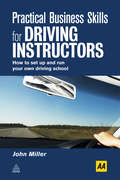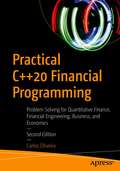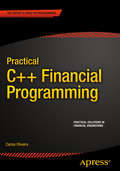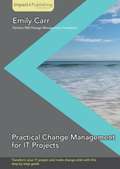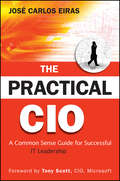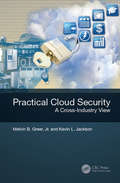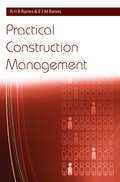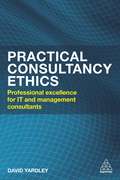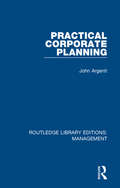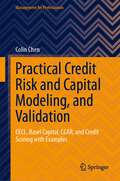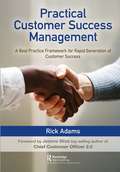- Table View
- List View
Practical A/B Testing: Creating Experimentation-driven Products
by Leemay NasseryWhether you're a catalyst for organizational change or have the support you need to create an engineering culture that embraces A/B testing, this book will help you do it right. The step-by-step instructions will demystify the entire process, from constructing an A/B test to breaking down the decision factors to build an engineering platform. When you're ready to run the A/B test of your dreams, you'll have the perfect blueprint.With smart, tactful approaches to orchestrating A/B testing on a product, you'll quickly discover how to reap all the benefits that A/B testing has to offer - benefits that span your users, your product, and your team. Take the reins today, and be the change you want to see in your engineering and product organizations.Develop a hypothesis statement that's backed with metrics that demonstrate if your prediction for the experiment is correct. Build more inclusive products by leveraging audience segmentation strategies and ad-hoc post analysis to better understand the impact of changes on specific user groups. Determine which path is best for your team when deciding whether to go with a third-party A/B test framework or to build the A/B testing platform in-house. And finally, learn how to cultivate an experimentation-friendly culture within your team.Leverage the A/B testing methodology to demonstrate the impact of changes on a product to your users, your key business metrics, and the way your team works together. After all, if you aren't measuring the impact of the changes you make, how will you know if you're truly making improvements?
The Practical Application of the Process Capability Study: Evolving From Product Control to Process Control
by Douglas B. RelyeaThis book shows readers how to use the process capability study to increase return on investment from their statistical process control/Six Sigma effort and make their company more competitive. It provides benefits to every department within a manufacturing organization.
Practical Applications of HR Analytics: A Step-by-Step Guide
by Pratyush Banerjee Jatin PandeyA comprehensive introduction to the know-how of HR analytics and its role in optimizing HR decision-making and driving organizational performance. In today's technology-driven world, HR analytics is pivotal to measure, express and take focused HR decisions. Practical Applications of HR Analytics equips readers with the required tools and techniques to effectively identify, capture and utilize the vast amount of available data in making better informed business decisions. The text is lucid and packed with practical illustrative examples, hands-on exercises and datasets. It is an invaluable resource for management students and HR professionals who want to translate the benefits of HR analytics into practice, thus paving the way for evidence-based human resource management. Key Features: • Practical understanding of a range of open-source statistical GUI software. • Focus on both descriptive and predictive analytics in HR. • Chapter opening vignettes, industry examples and real-world case studies on application of HR analytics in organizations. • Supplementary exercises and soft copy of datasets provided on Google Drive Link to facilitate hands-on training.
Practical Aspects of Rape Investigation: A Multidisciplinary Approach, (Practical Aspects of Criminal and Forensic Investigations)
by Robert R. Hazelwood Ann BurgessThe latest sixth edition of Practical Aspects of Rape Investigation is a fully updated, comprehensive volume on investigative procedures and victim-oriented case management for professionals assisting victims of rape and sexual assault.Rape and sexual assault cases have a devastating societal impact, particularly among the vulnerable populations most affected, including women, children, the elderly, minorities, and members of the LGBTQ+ communities. Such cases are all too common and, unfortunately, the number of cases continues to rise. As such, the need for a current reference on the topic has never been more pressing.Edited by Ann Wolbert Burgess—the subject of Hulu’s 2024 documentary series Mastermind: To Think Like a Killer, and an internationally recognized researcher and pioneer in the assessment and treatment of victims of trauma and abuse—this book covers various topics contributed to by experts from a broad range of fields. Leading academics, researchers, and investigative professionals address the problem of rape and sexual assault holistically, focusing on the core principles of real-world investigative techniques, behavioral profiling, investigative strategies and techniques, social worker involvement, and victimology.When a rape case goes undetected or unreported, a violent offender remains on the streets with the opportunity to reoffend—often repeatedly. Because victims are frequently reluctant to speak out or act in such cases, this book aims to raise awareness and, ultimately, decrease the number of silent victims and improve rape-investigative capabilities and outcomes.Practical Aspects of Rape Investigation, Sixth Edition provides the essential tools and techniques for professionals to best serve, and advocate for, victims. It continues to serve as an invaluable reference for students, legal professionals, and case managers, and as a blueprint for investigators and law enforcement professionals on case management best practices.
Practical Automated Machine Learning on Azure: Using Azure Machine Learning to Quickly Build AI Solutions
by Deepak Mukunthu Parashar Shah Wee Hyong TokDevelop smart applications without spending days and weeks building machine-learning models. With this practical book, you’ll learn how to apply automated machine learning (AutoML), a process that uses machine learning to help people build machine learning models. Deepak Mukunthu, Parashar Shah, and Wee Hyong Tok provide a mix of technical depth, hands-on examples, and case studies that show how customers are solving real-world problems with this technology.Building machine-learning models is an iterative and time-consuming process. Even those who know how to create ML models may be limited in how much they can explore. Once you complete this book, you’ll understand how to apply AutoML to your data right away.Learn how companies in different industries are benefiting from AutoMLGet started with AutoML using AzureExplore aspects such as algorithm selection, auto featurization, and hyperparameter tuningUnderstand how data analysts, BI professions, developers can use AutoML in their familiar tools and experiencesLearn how to get started using AutoML for use cases including classification, regression, and forecasting.
Practical Biostatistics for Medical and Health Sciences
by Seyed Hassan Saneii Hassan DoostiThis book addresses the challenge of presenting biostatistics to medical and health science audiences coherently. Tailored for students and researchers, its 13 chapters progress logically from foundational concepts like measurement scales and statistical calculations to advanced topics such as probability, correlation, regression and health and disease measures. Practical examples enhance relevance, and its gradual approach ensures easy comprehension even for non-statisticians. The book's practical emphasis shines as it culminates in teaching the use of SPSS software for result interpretation, bridging theory and practice effectively. It empowers medical professionals to confidently understand and apply statistical concepts in their work, serving as an indispensable resource in navigating the intricacies of biostatistics in medical and health sciences.
Practical Business Analytics Using SAS
by Venkat Reddy Konasani Shailendra KadrePractical Business Analytics Using SAS: A Hands-on Guide shows SAS users and businesspeople how to analyze data effectively in real-life business scenarios. The book begins with an introduction to analytics, analytical tools, and SAS programming. The authors--both SAS, statistics, analytics, and big data experts--first show how SAS is used in business, and then how to get started programming in SAS by importing data and learning how to manipulate it. Besides illustrating SAS basic functions, you will see how each function can be used to get the information you need to improve business performance. Each chapter offers hands-on exercises drawn from real business situations. The book then provides an overview of statistics, as well as instruction on exploring data, preparing it for analysis, and testing hypotheses. You will learn how to use SAS to perform analytics and model using both basic and advanced techniques like multiple regression, logistic regression, and time series analysis, among other topics. The book concludes with a chapter on analyzing big data. Illustrations from banking and other industries make the principles and methods come to life. Readers will find just enough theory to understand the practical examples and case studies, which cover all industries. Written for a corporate IT and programming audience that wants to upgrade skills or enter the analytics field, this book includes: More than 200 examples and exercises, including code and datasets for practice. Relevant examples for all industries. Case studies that show how to use SAS analytics to identify opportunities, solve complicated problems, and chart a course. Practical Business Analytics Using SAS: A Hands-on Guide gives you the tools you need to gain insight into the data at your fingertips, predict business conditions for better planning, and make excellent decisions. Whether you are in retail, finance, healthcare, manufacturing, government, or any other industry, this book will help your organization increase revenue, drive down costs, improve marketing, and satisfy customers better than ever before.
Practical Business Ethics For The Busy Manager
by M. Neil Browne Andrea Giampetro-Meyer Carrie WilliamsonWith a conversational writing style, rather than the language of formal ethical theories, this short, readable book suggests to its readers that they should plan how be better business people than they would otherwise be. It contains a common sense, practical approach to doing good work—emphasizing the need to prepare in advance for ethical dilemmas, long before they arise. KEY TOPICS Chapter topics cover American corporate and organizational culture, identifying personal values, moral mentors, getting the facts necessary for good work, determining the issue that requires good work, locating the relevant law, identifying the alternative options, and applying personal ethical principles to doing good work. For business people—and people who will one day be business people—who want to make a difference in business practice and improve behavior in their selves and business environment.
Practical Business Math: An Applications Approach
by Michael D. TuttleThe eighth edition of Practical Business Math: An Applications Approach continues the successful format of previous editions with an added emphasis on the integrated presentation that makes teaching and learning easier. This emphasis is sure to improve student understanding of business math topics.
Practical Business Math Procedures
by Jeffrey Slater Sharon M. WittryThe Thirteenth Edition of Practical Business Math Procedures provides students with an engaging and personalized way to learn, leading to success in the classroom and beyond. Respected authors Jeffrey Slater and Sharon Wittry incorporate examples from The Wall Street Journal and Kiplinger throughout the entirety of the text to reinforce real-world application of business math. Every chapter concludes with the "My Money" exercises, which encourage students to apply the chapter material to their personal finances while utilizing the Internet’s many resources. <P><P> Connect is the only integrated learning system that empowers students by continuously adapting to deliver precisely what they need, when they need it, and how they need it, so that your class time is more engaging and effective.
Practical Business Math Procedures
by Jeffrey Slater Sharon M. WittryKiplinger's Personal Finance is the most trustworthy source of advice and guidance available today on managing your money: how to make and save more of it, invest it profitably, spend it wisely, make it work harder for you, and much more.From our annual economic forecast issue to our ranking of the best mutual funds... from new ways to slash taxes, to the best ways to boost your credit score ... Kiplinger's Personal Finance is devoted to helping you make more money and keep more of the money you make!
Practical Business Math Procedures (9th Edition)
by Jeffrey SlaterThis book uses mathematical techniques to illustrate their application in business aspects.
Practical Business Negotiation
by William W. Baber Chavi C-Y Fletcher-ChenPractical Business Negotiation introduces university students to business negotiation as practiced in the globalized business world. There are no other textbooks that take on this topic in depth with non-native English speakers in mind. Current textbooks about negotiation tend to be dense, academic and less than practical in content. Many are demotivating to students who are not easily able to consume a few hundred pages of academic writing. This textbook takes a step by step approach, providing bite-sized presentations of negotiation concepts with practical exercises that include linguistic as well as negotiation content. Explanations are reinforced with practical questions and problem solving and recent examples drawn from a business world that includes much more than North America and Europe.
Practical Business Negotiation
by William W. Baber Chavi C-Y Fletcher-ChenKnown for its accessible approach and concrete real-life examples, the second edition of Practical Business Negotiation continues to equip users with the necessary, practical knowledge and tools to negotiate well in business. The book guides users through the negotiation process, on getting started, the sequence of actions, expectations when negotiating, applicable language, interacting with different cultures, and completing a negotiation. Each section of the book contains one or two key takeaways about planning, structuring, verbalizing, or understanding negotiation. Updated with solid case studies, the new edition also tackles cross-cultural communication and communication in the digital world. Users especially non-native English speakers will be able to horn their business negotiation skill by reading, discussing, and doing to become apt negotiators.
Practical Business Skills for Driving Instructors
by John MillerOver 20,000 people apply to become an Approved Driving Instructor each year, but whether you are a sole trader or franchisee, you will need more than just the instructional skills that are tested in the official DSA qualifying exams. Practical Business Skills for Driving Instructors, by the author of the definitive Driving Instructor's Handbook, provides solid, practical advice to help you set up your own business. Each business topic is dealt with in the author's down-to-earth style including: preparing a business plan, financing the business, choosing and maintaining a car, book-keeping, sales and marketing, and presenting a professional image. Whether you are just considering becoming a driving instructor, or have just passed your ADI exams, Practical Business Skills for Driving Instructors will help you ensure your new career is a huge success.
Practical C++20 Financial Programming: Problem Solving for Quantitative Finance, Financial Engineering, Business, and Economics
by Carlos OliveiraApply C++ to programming problems in the financial industry using this hands-on book, updated for C++20. It explains those aspects of the language that are more frequently used in writing financial software, including the Standard Template Library (STL), templates, and various numerical libraries. Practical C++20 Financial Programming also describes many of the important problems in financial engineering that are part of the day-to-day work of financial programmers in large investment banks and hedge funds. The author has extensive experience in the New York City financial industry that is now distilled into this handy guide. Focus is on providing working solutions for common programming problems. Examples are plentiful and provide value in the form of ready-to-use solutions that you can immediately apply in your day-to-day work. You’ll see examples of matrix manipulations, curve fitting, histogram generation, numerical integration, and differential equation analysis, and you’ll learn how all these techniques can be applied to some of the most common areas of financial software development. These areas include performance price forecasting, optimizing investment portfolios, and more. The book style is quick and to-the-point, delivering a refreshing view of what one needs to master in order to thrive as a C++ programmer in the financial industry. What You Will Learn Cover aspects of C++ especially relevant to financial programming Write working solutions to commonly encountered problems in finance Design efficient, numerical classes for use in finance, as well as to use those classes provided by Boost and other libraries Who This Book Is For Those who are new to programming for financial applications using C++, but should have some previous experience with C++.
Practical C++ Financial Programming
by Carlos OliveiraPractical C++ Financial Programming is a hands-on book for programmers wanting to apply C++ to programming problems in the financial industry. The book explains those aspects of the language that are more frequently used in writing financial software, including the STL, templates, and various numerical libraries. The book also describes many of the important problems in financial engineering that are part of the day-to-day work of financial programmers in large investment banks and hedge funds. The author has extensive experience in the New York City financial industry that is now distilled into this handy guide. Focus is on providing working solutions for common programming problems. Examples are plentiful and provide value in the form of ready-to-use solutions that you can immediately apply in your day-to-day work. You'll learn to design efficient, numerical classes for use in finance, as well as to use those classes provided by Boost and other libraries. You'll see examples of matrix manipulations, curve fitting, histogram generation, numerical integration, and differential equation analysis, and you'll learn how all these techniques can be applied to some of the most common areas of financial software development. These areas include performance price forecasting, optimizing investment portfolios, and more. The book style is quick and to-the-point, delivering a refreshing view of what one needs to master in order to thrive as a C++ programmer in the financial industry. Covers aspects of C++ especially relevant to financial programming. Provides working solutions to commonly-encountered problems in finance. Delivers in a refreshing and easy style with a strong focus on the practical. What you'll learn Understand the fundamental problem types in the financial market. Design algorithms to solve financial programming problems. Extend C++ through Python extensions and LUA modules. Employ third-party numeric libraries such as those from Boost. Properly engage key C++ features such as templates and exception handling. Benefit from new features in C++14, such as auto variables and closures. Who this book is for Practical C++ Financial Programming is for professionals or advanced students who have interest in learning C++ financial programming, especially in preparation for a professional career. Readers should have a working-knowledge of programming in C, C++, or some other C-like language. The book is also useful to current practitioners at financial institutions as a ready-reference to common development problems and techniques. Table of Contents The Fixed-Income Market The Equities Market C++ Programming Techniques in Finance Common Libraries for Financial Code Designing Numerical Classes Plotting Financial Data Linear Algebra Interpolation Calculating Roots of Equations Numerical Integration Solving Partial Differential Equations Algorithm Optimization Portfolio Optimization Monte Carlo Methods for Equity markets Extending Financial Libraries C++ with R and Octave Multithreading Appendix A: C++14 Features
Practical Change Management for IT Projects
by Emily CarrTransform your IT project and make change stick with this step-by-step guide. In today's fast-paced world of change, companies expect you to do more, with less. Drawing on over a decade of Change Management experience as a consultant with Fortune 500 companies including IBM and NCR, Emily Carr shares the secrets to making change happen smoothly. If your company is like most, the number one reason that projects have failed over the years don't have to do with technology. They have to do with people. People didn't like the new technology. People weren't trained properly on the change. People hadn't received adequate communications and didn't understand the change. Sound familiar? Project teams rarely forget to work on the technology, but they often forget to work with the people, and no matter how amazing your new technology is, it's useless unless people use it efficiently. This book will help you focus on the people. Packed with templates, checklists, and real-life examples, this user-friendly guide will provide you with the insights and guidance of an expert consultant, for a fraction of the price. You'll follow a clearly laid out path from Change Management novice to confident and prepared change manager. You'll be introduced to the Five Pillars of Change: Sponsorship, Stakeholder Management, Communication, Training, and Organization Design. You will work step-by-step through templates in each pillar to build and run a comprehensive Change Management plan tailor-made to your project and organization. About the Author: Emily Carr has been working as a Change Management consultant for over a decade. As a consultant, she has worked with Fortune 500 companies to develop and execute successful Change Management, communications, and training programs for large-scale business and IT projects. These programs have had global reach across the United States, Australia, India, Eastern Europe, and the Middle East. Emily is also the author of the popular Change Management blog, Practical Change Management.
The Practical CIO: A Common Sense Guide for Successful IT Leadership
by Jose Carlos Eiras Tony ScottThe IT executive's ultimate handbook for survival in a rapidly changing economy The Practical CIO: A Common Sense Guide for Successful IT Leadership provides needed advice for modern executives competing in a challenging global environment. <P><P>Proactively establish goals for IT Hold all vendors accountable Extract maximum value from existing IT investments Manage and market the IT brand Build relationships up, down and sideways across the enterprise and beyond its traditional boundaries Act like a CEO Brimming with interviews and case studies from leading global enterprises such as Microsoft, Prudential, Citigroup, Chiquita Brands, Smithfield Foods and West Marine. The Practical CIO is designed for clear-eyed IT and C-level executives with no patience for hype or overly optimistic visions of a "better tomorrow." Truly a commonsense guide for successful IT leadership, this book delivers exactly the kind of hard-nosed, actionable advice that executives urgently require.
Practical Cloud Security: A Cross-Industry View
by Melvin B. Greer, Jr. Kevin L. JacksonMelvin Greer and Kevin Jackson have assembled a comprehensive guide to industry-specific cybersecurity threats and provide a detailed risk management framework required to mitigate business risk associated with the adoption of cloud computing. This book can serve multiple purposes, not the least of which is documenting the breadth and severity of the challenges that today’s enterprises face, and the breadth of programmatic elements required to address these challenges. This has become a boardroom issue: Executives must not only exploit the potential of information technologies, but manage their potential risks. Key Features • Provides a cross-industry view of contemporary cloud computing security challenges, solutions, and lessons learned • Offers clear guidance for the development and execution of industry-specific cloud computing business and cybersecurity strategies • Provides insight into the interaction and cross-dependencies between industry business models and industry-specific cloud computing security requirements
Practical Construction Management
by R. H. Ranns E. J. RannsFilled with practical advice for all aspects of the construction manager's role, this invaluable book fills a need for training in this essential subject, to ensure greater efficiency on site and smoother client-contractor relations. Developed as a handy-reference guide for practitioners and also useful for students, it covers the broad range of responsibilities associated with the role, providing clear guidance and in-depth coverage of the essentials. Topics include financial responsibilities and how to handle them, tender preparation, people management, health and safety, contracts, subcontracting, measurement and quantities, insurance and risk and many more simple and effective methods for turning construction projects into reality.
Practical Consultancy Ethics: Professional Excellence for IT and Management Consultants
by David YardleyConsultants - working for an organization but not as part of it - are particularly subject to commercial pressures from both their employers and their clients, never more so than when consulting on complex and costly IT engagements. A consultant's reputation is crucial to their professional capital, and they have to be able to make defensible decisions that protect this reputation whilst delivering value for the client. This means acting ethically, responsibly and commercially. Practical Consultancy Ethics approaches the subject of ethics from the individual's perspective: the management or IT consultant who will need to make ethical decisions within their engagement. With clear-sighted identification of the ethical dilemmas that may arise at each stage of a consultancy project - from defining the problem to fit the solution, through to prioritizing competing stakeholder needs, and having access to confidential client information - and guidance on ethical and risk-reducing actions that consultants can take, the emphasis throughout is on improved decision-making. Enhanced with case studies showcasing real-life ethical pitfalls and featuring consultancy ethical dilemmas to challenge the reader, this is a uniquely practical guide to applying best ethical practice in consulting engagements.
Practical Corporate Planning: A Practical Guide (Routledge Library Editions: Management #4)
by John ArgentiIn this book, originally published in 1980, John Argenti deliberately and systematically strips away the sophisticated methods for corporate planning to get down to a practical corporate planning process that works. This accessible book uses no jargon or maths, and will be of interest to students of management and business studies. It is also aimed at chief executives, managing directors and other very senior executives in companies and non-profit-making organisations.
Practical Credit Risk and Capital Modeling, and Validation: CECL, Basel Capital, CCAR, and Credit Scoring with Examples (Management for Professionals)
by Colin ChenThis book provides professionals and practitioners with a comprehensive guide on credit risk modeling, capital modeling, and validation for Current Expected Credit Loss (CECL), International Financial Reporting Standard 9 (IFRS9), Basel Capital and Comprehensive Capital Analysis and Review (CCAR) procedures. It describes how credit risk modeling, capital modeling, and validation are done in big banks with code and examples. The book features innovative concepts such as Binary Logit Approximation (BLA) for Competing Risk Framework; Adaptive and Exhaustive Variable Selection (AEVS) for automatic modeling; Full Observation Stratified Sampling (FOSS) for unbiased sampling; and Prohibited Correlation Index (PCI) for Fair Lending Texts. It also features a chapter on credit underwriting and scoring, addressing the credit underwriting risk with some innovations. It is a valuable guide for professionals, practitioners and graduate students in risk management.
Practical Customer Success Management: A Best Practice Framework for Rapid Generation of Customer Success
by Rick Adams"This book contains so much common sense that my neck was getting tired from nodding my head in agreement so often." Peter Armaly, Senior Director Customer Success, Oracle "…a comprehensive review of the Customer Success role and responsibilities…" Anne Marie Ponder, Senior Manager, IT Infrastructure, Astellas Pharma US "…a must read playbook for all business leaders and customer success-focused professionals." Jason Noble, Global Customer Success and SaaS Leader "I wish a book like this existed when I started in Customer Success!" Cyn Taylor, Enterprise Customer Success Manager, LogicMonitor "…provides all the ingredients to create the right customer success strategy." Baptiste Debever, Head of Growth & Co Founder, Alkalab "…an invaluable resource for anyone with an interest in Customer Success." Adam Joseph, CEO, CSM insight "A structured and logical approach that will help new and experienced CSMs to bridge the gap between Customer Success theory and practical application." James Scott, General Partner, Success Hacker Customer success management is "the practice of helping customers to generate value from using our products" and it is a relatively new and fast-growing profession with many new CSMs coming into it from other customer-facing professions. Due to the speed with which the profession is undergoing change as it matures and expands, both new and existing CSMs need to keep abreast of customer success best practice. However there are relatively few books that provide much in the way of practical guidance for customer success practitioners and even less options for resources such as tools, templates and checklists that enable a consistently high quality approach whilst increasing the CSM’s productivity. Practical Customer Success Management is a practical guide book and comprehensive training manual for CSMs that provides a simple to follow, best practice framework that lays out the core steps at every stage of the customer journey to business outcome success. It describes and explains which situations each step applies to and provides recommendations for activities or tasks that the CSM can perform to complete each step, together with detailed guidance for successfully completing those activities. The book also includes a suite of tools and templates that enable rapid completion of tasks whilst ensuring consistency of approach both across multiple customer engagements and by multiple CSMs within a team.
